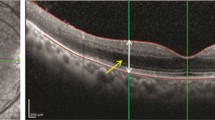Abstract
Purpose
To describe the clinical characteristics, macular structure and function, and to document sequential changes over 5 years in a 10-year-old boy with bilateral primary foveomacular retinitis.
Methods
A 10-year-old boy presented with sudden onset scotoma in both eyes, experienced after getting up from bed on a non-eclipse day. He persistently denied direct sun-gazing. He neither had any significant systemic illness, nor was using any medications. In addition to a detailed examination at presentation that included fundus fluorescein angiogram (FFA), electroretinogram (ERG), pattern ERG and electrooculogram (EOG), he was examined periodically for 5 years with Humphrey visual field (HVF), spectral domain optical coherence tomogram (SDOCT), Amsler grid charting and multifocal ERG. The macular structure and functions were analyzed over the years and correlated with the symptoms.
Results
All findings were bilaterally symmetrical at each visit. At presentation, his corrected visual acuity was 20/25 with subfoveal yellow dot similar to solar retinopathy, central scotoma with reduced foveal threshold in HVF 24-2, micropsia in Amsler grid, missing of two plates on Ishihara color vision chart, transfoveal full thickness hyper-reflective band on SD OCT, unremarkable FFA and normal foveal peak in mfERG. The flash ERG and EOG were unremarkable. A month later, his VA improved to 20/20, he had relative scotoma in Amsler grid, no scotoma in HVF (10-2), restoration of the inner segment of the photoreceptors with sharp defect involving ellipsoid and photoreceptor interdigitation zone in SDOCT and blunting of foveal peaks in mfERG. Three months later, his corrected VA was 20/20 with relative scotoma in Amsler grid, normal color vision, no scotoma in HVF 10-2 and unchanged SDOCT findings. In subsequent examinations at 6, 9, 14, 29, 39 and 60 months, he was symptomless with VA 20/20, unremarkable fundus, normal Amsler grid and HVF (normal foveal threshold), unchanged SDOCT findings and the reduced foveal peaks on mfERG in both eyes got normalized only at 60 months.
Conclusion
Presented here is a case of bilaterally symmetrical idiopathic foveomacular retinitis that had a clinical appearance similar to solar retinopathy. The fundus changes persisted for 4 weeks, the symptoms and changes in Amsler grid lasted for 3 months, and the foveal threshold in visual fields normalized within 3 months. Maximum change in the SDOCT defect occurred within a month, and the extrafoveal defect in the ellipsoid and photoreceptor interdigitation line persisted despite resolution of symptoms and resolution of the visual field defect and normal distance vision. Probably, the foveal lesion detected on SDOCT was too small to cause a reduction in the distance visual acuity or show up in the visual field and mfERG later.






Similar content being viewed by others
References
Gass JDM (1997) Stereoscopic atlas of macular diseases: diagnosis and treatment, 4th edn. Mosby, St. Louis
Hood DC, Bach M, Brigell M, Keating D, Kondo M, Lyons JS, Palmowski-Wolfe AM (2008) ISCEV guidelines for clinical multifocal electroretinography (2007 edition). Doc Ophthalmol 116:1–11
Chen RW, Gorczynska I, Srinivasan VJ et al (2008) High-speed ultrahigh-resolution optical coherence tomography findings in chronic solar retinopathy. Retin Cases Brief Rep 2(2):103–105
Jain A, Desai RU, Charalel RA et al (2009) Solar retinopathy comparison of optical coherence tomography (OCT) and fluorescein angiography (FA). Retina 29(9):340–345
Stock RA, Savaris SL, Lima Filho EC, Bonamigo EL (2013) Solar retinopathy without abnormal exposure: case report. Arq Bras Oftalmol 76:118–120
Comander J, Gardiner M, Loewenstein J (2011) High-resolution optical coherence tomography findings in solar maculopathy and the differential diagnosis of outer retinal holes. Am J Ophthalmol 152(3):413–419
Woldoff HS, Kilpatrick WRJ (1975) Foveomacular retinitis. Ann Ophthalmol 7:1035–1038
Wegeland FL, Brenner EH (1975) Solar retinopathy and foveomacular retinitis. Ann Ophthalmol 4:445–503
Kuming BS (1986) Foveomacular retinitis. Br J Ophthalmol 70:816–818
Tso MO, La Piana FG (1975) The human fovea after sungazing. Trans Am Acad Ophthalmol Otolaryngol 79(6):788–795
Hope-Ross MW, Mahon GJ, Gardiner TA, Archer DB (1993) Ultrastructural findings in solar retinopathy. Eye 7(1):29–33
Yannuzzi LA, Fisher YL, Slakter JS, Krueger A (1989) Solar retinopathy: a photobiologic and geophysical analysis. Retina 9(1):28–43
Garg SJ, Martidis A, Nelson ML, Sivalingam A (2004) Optical coherence tomography of chronic solar retinopathy. Am J Ophthalmol 137(2):351–354
Stangos AN, Petropoulos IK, Pournaras JC et al (2007) Optical coherence tomography and multifocal electroretinogram findings in chronic solar retinopathy. Am J Ophthalmol 144(1):31–34
Cho HJ, Yoo ES, Kim CG, Kim JW (2011) Comparison of spectral-domain and time-domain optical coherence tomography in solar retinopathy. Korean J Ophthalmol 25(4):278–281
Spaide R (2008) Autofluorescence from the outer retina and subretinal space: hypothesis and review. Retina 28(1):5–35
Schatz P, Eriksson U, Ponjavic V, Andréasson S (2004) Multifocal electroretinography and optical coherence tomography in two patients with solar retinopathy. Acta Ophthalmol Scand 82:476–480
Mack G, Uzel JL, Sahel J, Flament J (2002) Multifocal electroretinogram for assessing sun damage following the solar eclipse of 11 August 1999. J Fr Ophtalmol 25:380–387
Arda H, Oner A, Mutlu S et al (2007) Multifocal electroretinogram for assessing sun damage following the solar eclipse of 29 March 2006: multifocal electroretinography in solar maculopathy. Doc Ophthalmol 114(3):159–162
Author information
Authors and Affiliations
Corresponding author
Ethics declarations
Conflict of interest
Anurag Badhani, Tapas Ranjan Padhi, Gopal Krishna Panda, Sujoy Mukherjee, Taraprasad Das and Subhadra Jalali declare that they have no conflict of interest.
Statement of human rights
All procedures followed were in accordance with the ethical standards of the responsible committe on human experimentation (institutional and national) and with Helsinki Declaration of 1964.
Statement on the welfare of animals
Article does not contain any studies with animal subjects performed by any of the authors.
Informed consent
Informed consent was obtained from all patients for being included in study.
Rights and permissions
About this article
Cite this article
Badhani, A., Padhi, T.R., Panda, G.K. et al. Correlation of macular structure and function in a boy with primary foveomacular retinitis and sequence of changes over 5 years. Doc Ophthalmol 135, 43–52 (2017). https://doi.org/10.1007/s10633-017-9590-1
Received:
Accepted:
Published:
Issue Date:
DOI: https://doi.org/10.1007/s10633-017-9590-1




